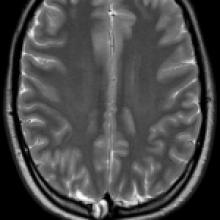Giant Arachnoid Granulation
- Arachnoid granulations are invaginations of the arachnoid membrane that perforate gaps in the dura and protrude into the lumen of the dural sinus. They are commonly found in the superior sagittal sinus and transverse sinus and often mistaken for dural sinus thrombosis. The are best seen in 3D contrast-enhanced MPRAGE imaging. Rarely, arachnoid granulations cause symptoms from venous hypertension secondary to partial sinus occlusion.
- They are termed “giant” when they grow over 1.5 cm (normally 0.5 – 1.5 cm).
- Clinical Presentation: Aysymptomatic
- Key Diagnostic Features:
- A well-defined hypodense lesion, appearing iso-slightly hyperintense to CSF on T1WI and FLAIR, and isointense to CSF on T2WI, is typically seen.
- A linear enhancing structure is seen coursing through the granulation itself, which represents the coursing vein. Such arachnoid granulations can project into the venous sinus, resulting in a “filling defect”. Occasionally, they can project into the calvarium.
- Smooth scalloping, especially of the inner table of the skull, is seen.
- DDx:
- Dural sinus thrombosis
- Dural arteriovenous fistula
- Arachnoid cyst
- Epidermoid
- Eosinophilic granuloma
- Rx: This is a normal structure and should not be mistaken for a thrombus. Hence, no treatment is necessary.







